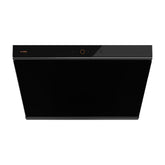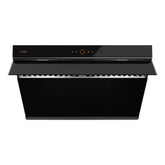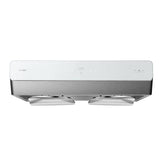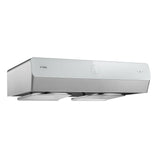How to Clean Stove Drip Pans: Easy Methods for Every Mess
Last Updated: 4/14/2025
Author: James Zhao, Sr. Tech Specialist & Alex Park, Product Specialist
Grease splatters, burnt-on sauce, and mystery grime—your stove’s drip pans catch it all. If you've been wondering how to clean stove drip pans without spending hours scrubbing, FOTILE can help.
In this guide, we’ll break down the easiest and most effective ways to clean stove drip pans, from quick touch-ups to tackling baked-on messes. With simple methods from FOTILE, you can keep your electric or gas stove looking spotless and performing its best.
If you’re ready to upgrade to a low-maintenance kitchen setup, FOTILE’s sleek electric ranges make cleanup a breeze. Our modern appliances reduce smoke, limit grease buildup, and keep your kitchen fresh every day. Browse our electric range collection and transform your cooking space today.
Why It’s Important to Keep Your Stove Drip Pans Clean
Dirty drip pans don’t just look bad—they can affect your stove’s performance. Grease and food buildup can cause smoke and unpleasant odors and even attract pests to your kitchen over time. By keeping your stove drip pans clean, you can improve kitchen hygiene, extend the lifespan of your appliances, and create a safer cooking environment.
What You’ll Need to Clean Stove Drip Pans
Before you start cleaning, gather these stove drip pan cleaning supplies to tackle everything from light grease to heavy, burnt-on messes:
- Dish soap
- Baking soda
- White vinegar
- A non-abrasive scrubbing pad or sponge
- A large bowl, bucket, or sink (for soaking)
- Paper towels or a clean drying cloth
- Optional: Ammonia (for deep cleaning)
Step-by-Step Guide to Cleaning Stove Drip Pans
Learning how to clean stove drip pans doesn’t have to be complicated. Follow these simple steps to cut through grease and get your stovetop looking fresh again:
1. Let your stove cool down: Before cleaning, make sure your stove is completely off and the drip pans are cool to the touch.
2. Remove the drip pans: Lift the burner coils (if you have an electric stove) or grates (if you have gas) and take out the drip pans.
3. Rinse off loose debris: Run the pans under warm water to rinse away any loose crumbs or grease.
4. Soak in a vinegar solution: Fill a sink or large bowl with equal parts hot water and white vinegar. Let the drip pans soak for at least 30 minutes.
5. Sprinkle with baking soda: After soaking, remove the pans and sprinkle a generous layer of baking soda over them. The vinegar soak loosens grime, while the baking soda allows for easy scrubbing.
6. Scrub gently: Use a sponge, old toothbrush, or non-abrasive pad to scrub away stains and residue. Balled-up aluminum foil can remove tougher spots without scratching your stove.
7. Rinse and dry: Rinse thoroughly with warm water and dry completely with a clean cloth or paper towels.
8. Reassemble your stove: Once everything is clean and dry, put the drip pans back in place and enjoy your sparkling stovetop.
Deep Cleaning Methods for Burnt-On Buildup
When everyday cleaning methods aren’t enough, try one of these deep cleaning options to tackle stubborn, burnt-on messes on your stove drip pans:
- Baking soda and dish soap paste: Mix equal parts baking soda and dish soap into a thick paste. Apply it generously to the drip pans and let it sit for at least an hour before scrubbing.
- Vinegar soak and baking soda scrub: Soak the drip pans in hot vinegar for 30 minutes. Then, sprinkle baking soda over the surface and scrub away the loosened grime.
- Ammonia bag method: Place each drip pan in a sealable plastic bag with ¼ cup of ammonia. Seal tightly and let sit overnight. The fumes break down baked-on grease. Rinse thoroughly afterward.
- Boiling water bath: Place the drip pans in a pot of boiling water for 10–15 minutes. This softens caked-on food and makes scrubbing easier afterward.
- Degreaser spray: Use a kitchen-safe degreasing spray on extremely dirty pans. Let it sit for the recommended time, then scrub and rinse well.
How to Prevent Future Buildup
Keeping stove drip pans clean is easier when you prevent messes before they start. Use these everyday habits to stay ahead of grease and grime:
- Wipe your stovetop and drip pans after each use while they’re still slightly warm.
- Clean up spills, splatters, and boil-overs promptly after the stove cools.
- Use foil or reusable drip pan liners for easy cleanup.
- Cook with lids to reduce splatter and moisture buildup.
- Do a monthly deep clean to prevent stubborn stains.
- Avoid excessive heat that can cause splatters to bake on the surface.
When to Replace Your Stove Drip Pans (& Your Oven)
Even with regular cleaning, stove drip pans don’t last forever. Over time, stains, rust, and wear can make them less effective—and less safe.
If you notice any of the following, it may be time to replace your stove drip pans:
- Rust or corrosion that won’t scrub off
- Warping or bending that prevents proper placement
- Peeling finishes that could contaminate food
- Persistent odors after cleaning
- Discoloration or heavy staining that affects performance
However, if your issues go beyond the drip pans—like uneven heating or constant repairs—it may be a sign that the oven itself is nearing the end of its life.
Consider replacing your oven if you’re experiencing:
- Uneven cooking or unreliable heating
- Constant breakdowns or frequent repairs
- Rising energy bills from an outdated appliance
- Outdated features or worn-out parts
- Burners, knobs, or components that show significant wear
Make Cleanups Easier with a Smarter Stove
Tired of scrubbing grime off your stove drip pans every week? FOTILE’s electric ranges keep messes minimal from the start. With precise heat control, low smoke output, and spill-resistant features, our appliances keep your kitchen looking fresh and feeling clean.
Explore FOTILE’s full collection of electric ranges today– invest in a cleaner, more sustainable kitchen.
- Choosing a selection results in a full page refresh.






